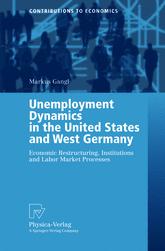|
Go to |
Abstract
The study provides a comparative empirical analysis of the dynamics of unemployment in the United States and West Germany. Based on longitudinal data and recent microeconometric methods, the analysis discusses different explanations for both the higher inflow into as well as the higher outflow from unemployment common in the United States. Despite cross-national differences in terms of the skill distribution and patterns of economic restructuring across industries and occupations, the study stresses institutional explanations for the observed country differences. Most importantly, more flexible U.S. labor markets contribute to higher labor turnover, resulting in both lower levels of job security, higher vacancy levels in external labor markets, and higher competitiveness of unemployed job seekers. Unemployment insurance, in turn, has only small effects on unemployment duration, yet contributes to smaller scar effects of unemployment among German workers.
Contents
| 1 | Dynamics of unemployment, jobs and careers: a cross-national perspective | |
| 2 | Dynamic perspectives on labor markets and unemployment | |
| 2.1 | Perspectives on unemployment dynamics | |
| 2.2 | A matching framework to explain unemployment flows | |
| 2.3 | Institutions, restructuring, and unemployment dynamics | |
| 2.4 | Summary | |
| 3 | Statistical methodology | |
| 3.1 | Data | |
| 3.2 | Statistical analysis of event history data | |
| 3.3 | Institutional inference and cross-national analysis | |
| 4 | Dynamics of employment and unemployment in the United States and West Germany | |
| 4.1 | The structure of unemployment | |
| 4.2 | Labor market flows | |
| 4.3 | Labor reallocation and turnover | |
| 4.4 | Unemployment dynamics | |
| 4.5 | Summary | |
| 5 | Unemployment incidence: labor turnover in the United States and West Germany | |
| 5.1 | Job losses and inflows into unemployment | |
| 5.2 | A structural model of turnover dynamics | |
| 5.3 | Unemployment risks and turnover components | |
| 5.4 | Institutions and economic restructuring | |
| 5.5 | Summary | |
| 6 | Unemployment duration and reemployment rates: a supply-side perspective | |
| 6.1 | Outflows from unemployment: jobs, training or withdrawal? | |
| 6.2 | Interdependencies between exit routes: responses to low reemployment prospects? | |
| 6.3 | Benefit effects revisited: Trade-offs between unemployment duration and reemployment outcomes | |
| 6.4 | Summary | |
| 7 | Opportunity, choice and reemployment rates: two-sided search and vacancy levels | |
| 7.1 | Job competition: which jobs for the unemployed? | |
| 7.2 | Sectoral effects on reemployment processes | |
| 7.3 | Reemployment rates and the structure of opportunity | |
| 7.4 | Structural sources of job opportunities | |
| 7.5 | Summary | |
| 8 | Summary and conclusions | |
| Appendix | ||
| References | ||
Markus Gangl is Senior Research Fellow at the Research Unit Labour Market Policy and Employment since July 2001. He studied Sociology, Economics, and Political Science at the Universities of Stuttgart and Mannheim, and has completed his PhD at the Faculty of Social Sciences at the University of Mannheim, Germany. His research interests are in the analysis of labour market careers, unemployment, income dynamics and poverty, but also include the statistical methods for the analysis of longitudinal data and the methodology of causal inference. At the WZB, he is conducting research on human capital effects of welfare state policies, and on the relation between welfare states and labour markets more generally. Markus Gangl is member of the American Sociological Association, the International Sociological Association (Research Committees 28 Social Stratification and Mobility and 33 Logic and Methodology), and the European Association of Labour Economists.
(Deutsch):Markus Gangl ist seit Juli 2001 als wissenschaftlicher Projektleiter in der Abteilung Arbeitsmarktpolitik und Beschäftigung. Er studierte Soziologie, Volkswirtschaftslehre und Politikwissenschaft an den Universitäten Mannheim und Stuttgart, und hat mit einer Arbeit über die Dynamik von Arbeitslosigkeit in der Bundesrepublik und den USA an der Fakultät für Sozialwissenschaften der Universität Mannheim promoviert. Seine Forschungsinteressen liegen in der dynamischen Analyse von Arbeitsmärkten, Erwerbsverläufen und Arbeitslosigkeit, aber auch im Bereich der Einkommens- und Armutsdynamik. Daneben beschäftigt er sich mit der Weiterentwicklung statistischer Verfahren der Kausal- und Längsschnittanalyse. Innerhalb der Abteilung liegt sein Forschungsschwerpunkt auf dem Verhältnis von Wohlfahrtsstaat und Arbeitsmarkt. Sein Hauptprojekt ist eine ländervergleichenden Studie zu den Humankapitaleffekten verschiedener wohlfahrtsstaatlicher Institutionen. Markus Gangl ist Mitglied der American Sociological Association, der International Sociological Association (Research Committees 28 Social Stratification and Mobility und 33 Logic and Methodology), sowie der European Association of Labour Economists.
